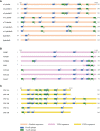"Immunoinformatic Identification of T-Cell and B-Cell Epitopes From Giardia lamblia Immunogenic Proteins as Candidates to Develop Peptide-Based Vaccines Against Giardiasis"
- PMID: 34778111
- PMCID: PMC8579046
- DOI: 10.3389/fcimb.2021.769446
"Immunoinformatic Identification of T-Cell and B-Cell Epitopes From Giardia lamblia Immunogenic Proteins as Candidates to Develop Peptide-Based Vaccines Against Giardiasis"
Abstract
Giardiasis is one of the most common gastrointestinal infections worldwide, mainly in developing countries. The etiological agent is the Giardia lamblia parasite. Giardiasis mainly affects children and immunocompromised people, causing symptoms such as diarrhea, dehydration, abdominal cramps, nausea, and malnutrition. In order to develop an effective vaccine against giardiasis, it is necessary to understand the host-Giardia interactions, the immunological mechanisms involved in protection against infection, and to characterize the parasite antigens that activate the host immune system. In this study, we identify and characterize potential T-cell and B-cell epitopes of Giardia immunogenic proteins by immunoinformatic approaches, and we discuss the potential role of those epitopes to stimulate the host´s immune system. We selected the main immunogenic and protective proteins of Giardia experimentally investigated. We predicted T-cell and B-cell epitopes using immunoinformatic tools (NetMHCII and BCPREDS). Variable surface proteins (VSPs), structural (giardins), metabolic, and cyst wall proteins were identified as the more relevant immunogens of G. lamblia. We described the protein sequences with the highest affinity to bind MHC class II molecules from mouse (I-Ak and I-Ad) and human (DRB1*03:01 and DRB1*13:01) alleles, as well as we selected promiscuous epitopes, which bind to the most common range of MHC class II molecules in human population. In addition, we identified the presence of conserved epitopes within the main protein families (giardins, VSP, CWP) of Giardia. To our knowledge, this is the first in silico study that analyze immunogenic proteins of G. lamblia by combining bioinformatics strategies to identify potential T-cell and B-cell epitopes, which can be potential candidates in the development of peptide-based vaccines. The bioinformatics analysis demonstrated in this study provides a deeper understanding of the Giardia immunogens that bind to critical molecules of the host immune system, such as MHC class II and antibodies, as well as strategies to rational design of peptide-based vaccine against giardiasis.
Keywords: epitope; immunogenic; immunoinformatic; protection; vaccine.
Copyright © 2021 Garzon, Ortega-Tirado, Lopez-Romero, Alday, Robles-Zepeda, Garibay-Escobar and Velazquez.
Conflict of interest statement
The authors declare that the research was conducted in the absence of any commercial or financial relationships that could be construed as a potential conflict of interest.
Figures




References
-
- AL-Khaliq I. M. A., Ghadban M. M., Karimau K. A. A. L. H. (2020). Influence of Human Leukocyte Antigen Hla-Drb1 on Susceptibility To Giardia Lamblia Infection of Iraqi Patients. Biochem. Cell. Arch. 20 (2), 5513–5516.
Publication types
MeSH terms
Substances
LinkOut - more resources
Full Text Sources
Medical
Research Materials

